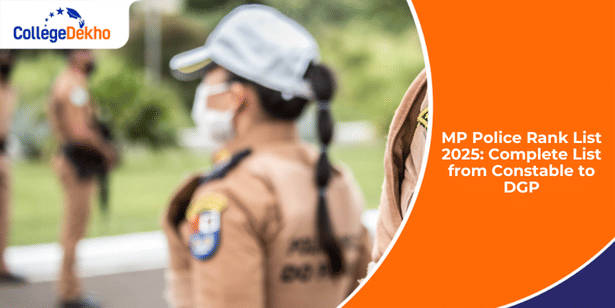
If you're preparing for MP Police exams, understanding the complete hierarchy is essential for your preparation. The Madhya Pradesh Police system is highly defined, where every rank has its own responsibility, power, and insignia. From a constable doing the ground work to a Director General looking after statewide operations, every post is worth equal importance in law and order situation. A clearly defined structure is advantageous for effective policing as well as giving clear career paths to aspirants like you.
MP Police Rank List 2025: Complete List from Constable to DGP
Check here the complete MP Police rank list from the top level to the lower level:
Level | Rank / Post | Notes |
|---|---|---|
1 | Director General of Police (DGP) | Head of the MP Police Force |
2 | Additional Director General of Police (ADGP) | Senior IPS rank under DGP |
3 | Inspector General of Police (IG) | Heads range or major divisions |
4 | Deputy Inspector General of Police (DIG) | Supervises several districts/ranges |
5 | Superintendent of Police (SP) | Head of district police (or equivalent) |
6 | Additional Superintendent of Police (Addl. SP) | Assists SP; subordinate gazetted officer |
7 | Deputy Superintendent of Police (Dy. SP) / CSP* | Entry-level gazetted officer in the state police cadre |
8 | Inspector of Police | Non-gazetted rank, often in charge of police circles or stations |
9 | Sub-Inspector of Police (SI) | Investigating a middle-level officer |
10 | Assistant Sub-Inspector of Police (ASI) | Assist SI; supervises constables |
11 | Head Constable | Senior constabulary rank |
12 | Constable | Base/entry rank in the police force |
Since you have an idea about the MP Police hierarchy, let's delve into understanding the ranks in detail, beginning from the top and going downwards to the base.
1. Director General of Police (DGP) – Head of MP Police
The DGP is the highest-ranked officer in the hierarchy of the Madhya Pradesh Police. He commands the entire state police force and is responsible for setting the overall strategic direction for law enforcement.
Aspect | Details |
|---|---|
Full Designation | Director General of Police |
Hierarchy Level | Topmost rank in MP Police |
Appointment Authority | State Government (IPS cadre) |
Primary Responsibilities | Overall police leadership, policy formation, coordination with Home Ministry, strategic planning |
Badge (Insignia) | National emblem with crossed sword & baton in a wreath |
2. Additional Director General of Police (ADGP) – Senior Support to DGP
As the second highest in rank, the ADGP usually heads specialized departments within the police force and plays an important role by assisting the DGP.
Aspect | Details |
|---|---|
Full Designation | Additional Director General of Police |
Hierarchy Level | Second-highest rank |
Appointment Authority | State Government (IPS officer) |
Primary Responsibilities | Leads specialized units like Crime Branch, Police Training Academy, Traffic Management, Cyber Cell, Special Operations |
Badge (Insignia) | National emblem with a star above |
3. Inspector General of Police (IG) – Range Commander
The Inspector-General manages an entire range of police covering several districts. This rank is crucial for coordinating law enforcement over large geographical areas.
Aspect | Details |
|---|---|
Full Designation | Inspector General of Police |
Hierarchy Level | Senior IPS officer rank |
Primary Responsibilities | Supervises Superintendents of Police across multiple districts, ensures inter-district coordination, monitors law and order in entire range |
Badge (Insignia) | National emblem with crossed sword & baton |
Cadre | Indian Police Service (IPS) |
4. Deputy Inspector General of Police (DIG) – Regional Supervisor
DIGs work under the IGs by looking after a district cluster and providing the necessary supervision and guidance at the level of district officers.
Aspect | Details |
|---|---|
Full Designation | Deputy Inspector General of Police |
Hierarchy Level | Mid-senior IPS rank |
Primary Responsibilities | Guides and monitors SPs, manages regional law & order, oversees crime prevention strategies, conducts inspections |
Badge (Insignia) | National emblem with three stars |
5. Superintendent of Police (SP) – District Chief
The Superintendent of Police is the chief officer in charge of the police organization within a district, so it is one of the most prominent and pertinent among the leadership profiles within the hierarchy.
Aspect | Details |
|---|---|
Full Designation | Superintendent of Police |
Hierarchy Level | District head officer |
Primary Responsibilities | District crime control, traffic management, law & order maintenance, all district police operations, public relations |
Badge (Insignia) | National emblem with one star below |
Cadre | IPS / State Police Service (SPS) |
6. Additional Superintendent of Police (Addl. SP) – Deputy to District Chief
The additional Superintendent of Police assists the superintendent of police and often directs specialized wings operating within the district police structure.
Aspect | Details |
|---|---|
Full Designation | Additional Superintendent of Police |
Hierarchy Level | Just below SP in district hierarchy |
Primary Responsibilities | Assists SP in operations, may lead anti-narcotics unit, women's cell, cyber wing, or rural policing |
Badge (Insignia) | National emblem |
7. Deputy Superintendent of Police (Dy. SP) – Entry-Level Gazetted Officer
The Dy. SP is the first officer-level post one can achieve through state exams where the officer is in charge of the police work in a subdivision of a district.
Aspect | Details |
|---|---|
Full Designation | Deputy Superintendent of Police |
Hierarchy Level | Subdivision in-charge |
Primary Responsibilities | Supervises multiple police stations, leads criminal investigations, maintains law and order in subdivision |
Badge (Insignia) | Three stars |
How to Become One | Through MPPSC exam (State Police Service) |
8. Inspector of Police – Station or Circle In-Charge
The Inspectors are senior officers. They usually manage a police station or a group of police stations, supervising the work of the SIs and other staff.
Aspect | Details |
|---|---|
Full Designation | Police Inspector |
Hierarchy Level | Senior officer below Dy. SP |
Primary Responsibilities | In-charge of police stations or circles, supervises Sub-Inspectors and ASIs, ensures proper investigation of cases |
Badge (Insignia) | Three stars with red & blue ribbon |
9. Sub-Inspector (SI) – Investigation Officer
In police investigations, sub-inspectors usually ought to be handling the greater bulk of the investigative work and the case management at the police station level.
Aspect | Details |
|---|---|
Full Designation | Sub-Inspector of Police |
Hierarchy Level | Officer below Inspector |
Primary Responsibilities | Registers FIRs, conducts investigations, prepares charge sheets, supervises ASIs and Constables, court appearances |
Badge (Insignia) | Two stars |
How to Become One | Direct recruitment via MP Police SI exam |
10. Assistant Sub-Inspector (ASI) – Supporting Investigation and Administration
To aid various investigations, Assistant Sub-Inspectors (ASIs) perform valuable work while simultaneously performing administrative duties in various police stations.
Aspect | Details |
|---|---|
Full Designation | Assistant Sub-Inspector |
Hierarchy Level | Below SI rank |
Primary Responsibilities | Assists in investigations, supervises Head Constables, maintains station records, handles administrative duties |
Badge (Insignia) | One star |
How to Join | Direct recruitment or promotion from Head Constable |
11. Head Constable – Senior Constabulary Rank
Head Constables are experienced officers promoted from the constable rank to take supervisory responsibilities.
Aspect | Details |
|---|---|
Full Designation | Head Constable |
Hierarchy Level | Senior constabulary post |
Primary Responsibilities | Leads constables on duty, maintains station registers, assists SIs and ASIs, handles clerical work, trains junior staff |
Badge (Insignia) | Stripes on uniform |
How to Become One | Promotion from Constable rank |
12. Constable – Foundation of the Force
Being the entry point of the police force, constables are at the very foundation of the police system, performing frontline duties, maintaining direct public contact, etc.
Aspect | Details |
|---|---|
Full Designation | Constable |
Hierarchy Level | Entry-level position |
Primary Responsibilities | Street patrolling, assisting in law & order, filing daily reports, frontline duties, crowd control, traffic duty, beat rounds |
Badge (Insignia) | No insignia (plain uniform) |
How to Join | Direct recruitment through MP Police Constable Exam |
The MP Police hierarchy safeguards proficient law enforcement through clearly defined roles and responsibilities at each level. Knowing this structure will help you understand where you might fit in and equip you for planning your career accordingly. For further knowledge on police ranks across India, check out our comprehensive article Police Ranks In India: Complete Rank-wise Post List with Salary & Badges to make comparisons of how different states organize their respective police services.
Are you feeling lost and unsure about what career path to take after completing 12th standard?
Say goodbye to confusion and hello to a bright future!

Was this article helpful?





















Similar Articles
Highest Paying Jobs for B.Arch Graduates in India
Can B.Arch be Pursued through Distance Education?
Top 10 Coding Courses for College Students
95 Marks in AP TET 2025 vs AP DSC Weightage Analysis
Which NITs have B.Arch courses?
B.Arch Admission Guide 2026 for Foreign Nationals